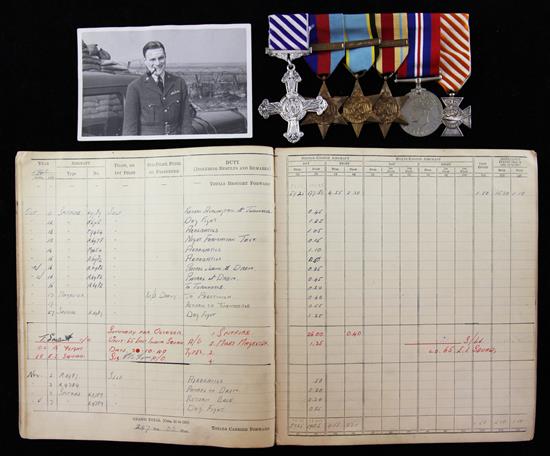I joined up as a youngster for a bit of fun, but it didn’t turn out like that. We were young men made old before our time. I felt then, that I had to go to the help of these lads. After all, they were my pals. Five men tried to get through and I was the sixth. I made a dive and got through. The worst part was that I didn’t know just where our chaps were. I had to find them, and in a run for about 150 yards I went within five yards of one of Jerry’s machine-guns. It was my lucky day.’ James Towers V.C., reflects upon events at Mericourt on 6 October 1918 (The Lancashire Daily Post, 12 November 1929, refers). The outstanding Great War ‘Final Advance of the Allies’ V.C. group of five awarded to Private James Towers 2nd Battalion, The Cameronians (Scottish Rifles), who volunteered to carry a vital message to a stranded platoon under a galling fire at Mericourt in October 1918 - after five of his comrades had been killed before his eyes in attempting to carry out the very same task: as The Times later observed, survivors possessed of such boldness and who ‘so clearly risked their all on one tremendous stake’ were protected by a special ‘charm’ A Lancashire lad from Preston, hard working and modest by nature, it is said Towers had a natural sporting ability, the result of leaping dykes and fences on his father’s farm. If so, it was an ability that served him well, for the moment he broke cover on his seemingly suicidal mission, heavy enfilading machine-gun fire was upon him: darting from shell-hole to shell-hole, and crawling through wire entanglements, he came across the slumped body of the first volunteer runner - one of his best friends, Private Frank Dunlop Undeterred, Towers continued on his way, taking a running leap at an embankment and landing within yards of an enemy machine-post the other side - but in several bounds he disappeared in the mist before the startled German gunners had time to react: shortly afterwards he delivered his vital message to the stranded platoon and led it to safety the following day Victoria Cross (30245 Pte. J. Towers, 2nd Bn. Sco. Rif.; 6 Oct. 1918), with its Hancocks & Co. case of issue; British War and Victory Medals (30245 Pte. J. Towers, Sco. Rif.); Coronation 1937; Coronation 1953, generally very fine (5) £130000-160000 Footnote V.C. London Gazette 6 January 1919: ‘For most conspicuous gallantry and devotion to duty at Mericourt on 6 October 1918, when, under heavy fire, five runners having failed to deliver an important message, Private Towers, well aware of the fate of the runners who had already attempted the task, volunteered for the duty. In spite of heavy fire opened on him as soon as he moved, he went straight through from cover to cover and eventually delivered the message. His valour, determination, and utter disregard of danger were an inspiring example to all.’ James Towers was born at 8 Wildman Street, Preston, Lancashire on 8 September 1897, the son of James and Betty Towers. At the time of his birth his father was employed as a cotton loomer but he later took up farming at Broughton, in which work he was assisted by young James after he had attended Emmanuel Boys School. Enlisting underage in the West Lancashire Artillery in July 1915, James was quickly discharged when his true age was established, but he re-enlisted in the 5th Dragoon Guards in August 1916. Subsequently transferred to the infantry, he joined the 2nd Battalion, The Cameronians (Scottish Rifles), and went to France in December 1916, where his unit formed part of 59th Infantry Brigade, 20th Division. Suicidal mission - V.C. On 6 October 1918, Towers and his comrades in the 2nd Battalion found themselves holding a railway embankment at Mericourt, three miles south-west of Lens. Under considerable pressure from the enemy, orders were given to retire, an order which failed to reach a platoon in ‘B’ Company as it had become cut-off between the lines of advancing Germans. A volunteer was called for, a runner to pas
I joined up as a youngster for a bit of fun, but it didn’t turn out like that. We were young men made old before our time. I felt then, that I had to go to the help of these lads. After all, they were my pals. Five men tried to get through and I was the sixth. I made a dive and got through. The worst part was that I didn’t know just where our chaps were. I had to find them, and in a run for about 150 yards I went within five yards of one of Jerry’s machine-guns. It was my lucky day.’ James Towers V.C., reflects upon events at Mericourt on 6 October 1918 (The Lancashire Daily Post, 12 November 1929, refers). The outstanding Great War ‘Final Advance of the Allies’ V.C. group of five awarded to Private James Towers 2nd Battalion, The Cameronians (Scottish Rifles), who volunteered to carry a vital message to a stranded platoon under a galling fire at Mericourt in October 1918 - after five of his comrades had been killed before his eyes in attempting to carry out the very same task: as The Times later observed, survivors possessed of such boldness and who ‘so clearly risked their all on one tremendous stake’ were protected by a special ‘charm’ A Lancashire lad from Preston, hard working and modest by nature, it is said Towers had a natural sporting ability, the result of leaping dykes and fences on his father’s farm. If so, it was an ability that served him well, for the moment he broke cover on his seemingly suicidal mission, heavy enfilading machine-gun fire was upon him: darting from shell-hole to shell-hole, and crawling through wire entanglements, he came across the slumped body of the first volunteer runner - one of his best friends, Private Frank Dunlop Undeterred, Towers continued on his way, taking a running leap at an embankment and landing within yards of an enemy machine-post the other side - but in several bounds he disappeared in the mist before the startled German gunners had time to react: shortly afterwards he delivered his vital message to the stranded platoon and led it to safety the following day Victoria Cross (30245 Pte. J. Towers, 2nd Bn. Sco. Rif.; 6 Oct. 1918), with its Hancocks & Co. case of issue; British War and Victory Medals (30245 Pte. J. Towers, Sco. Rif.); Coronation 1937; Coronation 1953, generally very fine (5) £130000-160000 Footnote V.C. London Gazette 6 January 1919: ‘For most conspicuous gallantry and devotion to duty at Mericourt on 6 October 1918, when, under heavy fire, five runners having failed to deliver an important message, Private Towers, well aware of the fate of the runners who had already attempted the task, volunteered for the duty. In spite of heavy fire opened on him as soon as he moved, he went straight through from cover to cover and eventually delivered the message. His valour, determination, and utter disregard of danger were an inspiring example to all.’ James Towers was born at 8 Wildman Street, Preston, Lancashire on 8 September 1897, the son of James and Betty Towers. At the time of his birth his father was employed as a cotton loomer but he later took up farming at Broughton, in which work he was assisted by young James after he had attended Emmanuel Boys School. Enlisting underage in the West Lancashire Artillery in July 1915, James was quickly discharged when his true age was established, but he re-enlisted in the 5th Dragoon Guards in August 1916. Subsequently transferred to the infantry, he joined the 2nd Battalion, The Cameronians (Scottish Rifles), and went to France in December 1916, where his unit formed part of 59th Infantry Brigade, 20th Division. Suicidal mission - V.C. On 6 October 1918, Towers and his comrades in the 2nd Battalion found themselves holding a railway embankment at Mericourt, three miles south-west of Lens. Under considerable pressure from the enemy, orders were given to retire, an order which failed to reach a platoon in ‘B’ Company as it had become cut-off between the lines of advancing Germans. A volunteer was called for, a runner to pas









/60258/Internet%20Image%203.jpg)
/88034/Internet%20Image%201.jpg)
/56176/Internet%20Image%201.jpg)
/33806/Internet%20Image%201.jpg)


Testen Sie LotSearch und seine Premium-Features 7 Tage - ohne Kosten!
Lassen Sie sich automatisch über neue Objekte in kommenden Auktionen benachrichtigen.
Suchauftrag anlegen